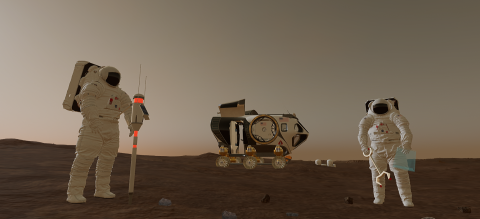Recreating scenarios with conditions similar to those of Mart so that the astronauts can train can be very costly. For this reason, NASA is using a Virtual Reality simulation to make these scenarios. During the month from May to July, NASA presented MarsXR Challenge, a contest destined to improve this Mars simulator through crowdsourcing, ua working method where the public is invited to contribute ideas or solutions to certain tasks.
The contest was aimed at creating scenarios or tools that could be used to train astronauts in extra-vehicular activity scenarios (EVA). The different categories where solutions could be presented were:
- Camp assembly: destined to all those tasks that had to do with the preparation of the habitat, such as assembling solar panels, assembling the wiring of the habitat or a greenhouse to grow food.
- Scientific research: destined to all those tasks related to the capture of Martian information, such as the collection of samples from the soil, the collection of meteorological data or environmental radiation.
- Exploration: for tasks related to the exploration of the land and the search for places of interest.
- Maintenance: for tasks to maintain the proper functioning of the equipment in use. Examples of possible solutions are to make a stage to clean the solar panels of the dust that they end up acquiring, to make a stage with the analysis and maintenance of the rovers or the exploration vehicle, or to make tools that help to make the cleaning of the habitat.
- Other proposals: this category includes all other scenarios or ideas that you may have, as long as they meet the objective of the contest. Some examples in this category are the creation of a belt to store the tools, so that they are not manually loaded, or the creation of an enclosure system attached to the treatment (EVA suit).
The 2200 contestants were able to access a part of this simulation, which contained 400km² of the Mart terrain, the Jezero crater (obtained from satellite images), with day and night cycles, realistic weather and gravity conditions, and other tools to facilitate the development of solutions. The simulation has been done using Epic Games’ software, Unreal Engine 5. (If you want to take a look at the simulator, you can download it from Epic Games, searching “NASA XOSS MarsXR Editor”).
In this contest, the inLaber Pol Sturlese participated in the Overheat team, one of the winning teams that developed solution for different categories. The team will deliver 5 different scenarios, and all of them were awarded. Among the most outstanding deliverables are the simulation of the assembly and connection of solar panels, and the mission and set of tools for the collection of soil samples for subsequent analysis. You can see some short videos of the 5 deliveries made by the team in the following links:
- Exploring team: https://www.youtube.com/watch?v=8jZRd3c7uns
- Solar panels assembly: https://www.youtube.com/watch?v=FExHCrEyqBg
- Research of the terrain: https://www.youtube.com/watch?v=05dLQWnF-JM
- Ground sampling: https://www.youtube.com/watch?v=Q3QYfeX2dIw
- Other proposals: https://www.youtube.com/watch?v=mE9jgjM7pJU
For more information about the contest or future calls, you can search NASA’s web, or the contest’s web.
